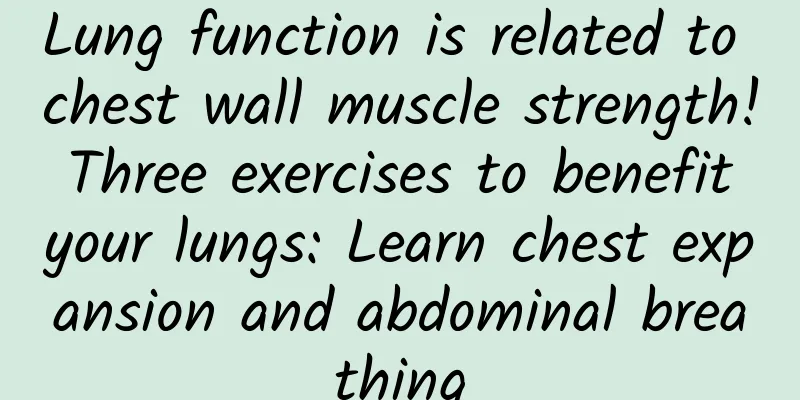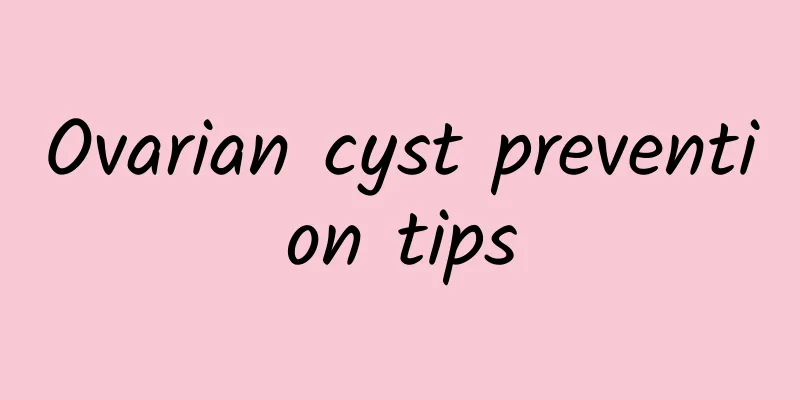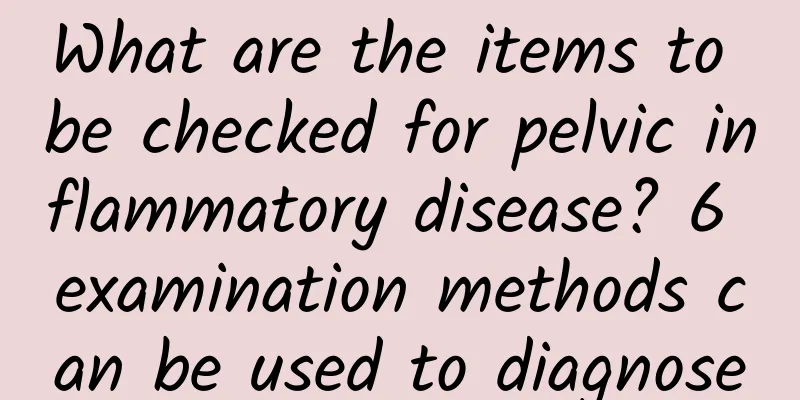Lung function is related to chest wall muscle strength! Three exercises to benefit your lungs: Learn chest expansion and abdominal breathing

|
The lungs are large in size, but they are useless if the air cannot be exhaled. For example, smokers or asthma patients have narrow airways and very little air can be used at a moment. If the airways are constricted to the point where they cannot breathe, their lives will be in danger. Ordinary people must also have unobstructed respiratory tracts to have sufficient oxygen for the body to use. Otherwise, long-term lack of blood oxygen will affect body functions and cause disease. The amount of exhaled air shows whether the airway is open and also represents a person's coughing ability. When conducting a lung function test, forced expiratory volume in one second (FEV1) and peak expiratory flow rate (PEFR) are used as indicators to understand the amount of gas entering and leaving the lungs during breathing and its flow rate. When a person's lung volume and respiratory flow rate are normal, ventilation function is generally normal when evaluated together with vital capacity. Before lung surgery, lung function tests will be performed using a spirometer. The main reference indicator is the forced expiratory volume in one second (FEV1). This is because it takes an average of three seconds for a person to exhale completely, and most of the air is exhaled in the first second. Testing FEV1 is more accurate and can be used to estimate coughing ability and surgical safety, the patient's postoperative survival rate and the impact on future life. If the surgery is more complicated, cardiac ultrasound and exercise lung function tests are also required. The oxygenation capacity of the lungs refers to their gas exchange capacity. Just as the gastrointestinal tract, in addition to having a sound structure, also needs to have good absorption capacity; when oxygen enters the lungs, it will diffuse to complete oxygenation. However, if the alveolar membrane is fibrotic due to disease or smoking, even if the inhaled air reaches the alveoli, the oxygen cannot penetrate the alveolar membrane for the body to use, and is useless. In addition to the above, lung function is also related to the strength of the chest wall muscles and diaphragm. Our chest cavity acts like a pump when we breathe. When we inhale, the ribs move outward and the diaphragm sinks, causing the chest cavity to expand and the abdominal cavity to shrink. When we exhale, the diaphragm rises and the chest wall contracts inward, squeezing out the carbon dioxide in the lungs. Therefore, when inhaling, the chest wall should be expanded to the maximum and the diaphragm should be compressed to the minimum, so that the lung capacity can be increased. Modern people who sit for long periods of time or have the habit of hunching over may compress the lungs and affect vital capacity. The lack of high-intensity exercise will also lead to the inability of related muscles to move vigorously, making the amount of exhaled gas small and weak. Therefore, if you want to enhance respiratory function and increase lung capacity, it is necessary to do more chest wall muscle and diaphragm strength training. Simple exercises in daily life that are beneficial to lung function Strengthening muscle strength and improving breathing efficiency are ways to exercise lung capacity. Lung capacity can be improved by training the chest wall muscles and diaphragm. For example, practicing abdominal breathing, doing various exercises that can strengthen the upper arm muscles, and doing more deep breathing and chest expansion exercises on a regular basis, etc., if done persistently, will greatly help maintain respiratory function and increase chest wall elasticity. Here are some daily exercises that can improve lung function: Chest expansion exercise: The chest cavity, like the joints of the limbs, needs regular fixed stretching exercises. Chest expansion exercise is to raise the hands and abduct them to help us open the chest cavity and breathe in more air. Studies have shown that humans take about three to four deep breaths unconsciously within an hour, which helps stretch the thorax and open the chest cavity (see Figure 2). Chest expansion exercises. (Photo provided by CommonWealth Publishing) Chest expansion exercises. (Photo provided by CommonWealth Publishing) Chest expansion exercises (Figure 2). (Photo provided by CommonWealth Publishing) It should be noted that this movement is not for training the hands, but for training the chest cavity. The chest cavity must be stretched to be effective. Many of the middle-aged people in Taiwan did the national health exercises when they were students, which included movements such as extending your hands and sticking out your chest. You can recall and try doing them. It is recommended that you get up and move around every half an hour, do some chest expansion exercises, and take deep breaths. You should also try to keep your head and chest up, reduce using your phone, avoid hunching your back, and provide enough space for the lungs to breathe. Abdominal breathing: Breathing must be efficient and of high quality. If the breathing is too shallow, the gas is only exchanged in the upper lung lobes, which cannot fully meet the body's needs. Abdominal breathing can improve diaphragm function, reduce respiratory rate, and increase chest mobility (see Figure 3). Abdominal exercise (Figure 3). (Photo provided by CommonWealth Publishing) The method is to exhale first, then take a deep breath through your nose. Place your hands on your abdomen while inhaling, and feel your abdomen gradually bulging. Imagine it is a balloon that is filled with air. When you have inhaled to the limit, purse your lips and exhale slowly. At this time, you should feel your abdomen shrinking and gradually becoming flat again. While inhaling, you can also let your shoulders extend backward and outward to help expand your lungs, and when you exhale, your shoulders will slowly return to their original position. The recommended time ratio for inhalation and exhalation should be one to two or one to three. You can do this three times a day, one hundred times each time, to increase your lung capacity. However, if you feel dizzy or uncomfortable during the exercise, stop immediately. This may be caused by exhaling too much carbon dioxide. Rounded lip breathing: This is a method of training exhalation. The benefit is that it can maintain a certain pressure in the respiratory tract, reduce the collapse of alveoli in the lungs, train the strength of the respiratory muscles, and increase the gas exchange function of the lungs. In addition, this breathing method can also make people feel relaxed, reduce anxiety, and reduce the number of breaths. When practicing, choose a position that you feel comfortable in, relax your shoulders, sit up straight, lean your head forward, and support your thighs or the table with your hands. When inhaling, breathe in through your nose and count to one or two in your mind. At this time, you must close your mouth to avoid dry mouth and air leakage. When exhaling, purse your lips (like blowing out a candle) and slowly exhale the air through your mouth. The length of exhalation is about twice that of inhalation, so when exhaling, you should silently count one, two, three, four in your mind (see Figure 4). Rounded lip breathing helps keep the airway open. You can practice it for ten minutes every day, once in the morning, noon, afternoon, and evening. After practicing for a few times, you will gradually feel your breathing becoming easier or smoother. Rounded lip breathing (Figure 4) (Photo courtesy of CommonWealth Publishing) For chest expansion exercises, abdominal breathing, and lip breathing, please refer to the National Taiwan University Hospital Physical Therapy Center's "Breathing Exercises for COVID-19 Patients Before and After Discharge" demonstration video. Although it is a breathing exercise demonstration provided to COVID-19 patients, the methods are the same. Video link: https://reurl.cc/g25ap4. This article is from the book "Prevention and Treatment of Lung Cancer" by Tianxia Culture |
>>: Can sauna and massage remove subcutaneous fat? Eliminate subcutaneous fat by doing this
Recommend
Let fat change your face! Lemonade weight loss craze is back
As the weather gets warmer, the lemon water weigh...
How to prevent cervicitis
Cervicitis is a common gynecological disease, usu...
What are the symptoms of mild cervical erosion? Four key points to prevent mild cervical erosion
The early symptoms of mild cervical erosion are o...
What are the precautions for treating irregular menstruation?
Irregular menstruation is a common disease that o...
Unmarried women can also suffer from adnexitis
Adnexitis refers to inflammation of the ovaries a...
What are the hazards of Bartholin's gland cyst?
What harm does a Bartholin's gland cyst cause...
My period is always about 5 days early, but the amount of menstrual flow is not much. What's going on?
My period is always about 5 days early, but the a...
What to do if endocrine causes irregular menstruation
What should I do if I have menstrual irregulariti...
Can eating green peppers and guava really prevent dark spots? Nutritionist Xia Ziwen: 4 nutrients to fight dark spots
When exposed to ultraviolet rays, it is easy to s...
Will ovarian cysts recur? What should patients pay attention to?
Has the ovarian cyst recurred? What should patien...
To protect your cardiovascular system, first stay away from the three highs! Two-pronged approach to regulating blood lipids and lowering cholesterol
The three highs are civilization diseases for mod...
What tests are needed for cervicitis
The symptoms of cervicitis mainly include cervica...
Advances in diagnosis and treatment of endometrial tuberculosis
What is the diagnosis method of endometrial tuber...
Will there be pregnancy reactions in ectopic pregnancy?
Ectopic pregnancy, also known as ectopic pregnanc...
Learn more about the treatment of clinically critical vaginitis
We must have a positive attitude towards the trea...









